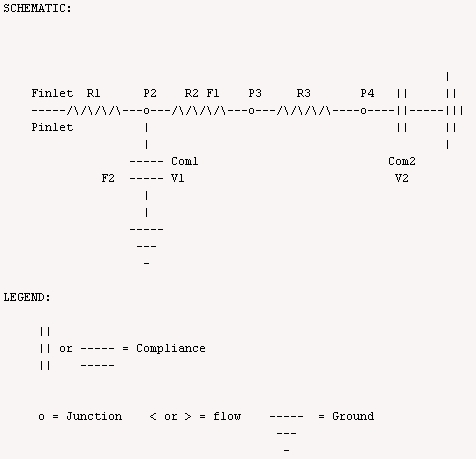This model represents a compliant bronchiole with a compliant alveolar sac. The driving force for this model is a pressure gradient which represents the difference in the alveolar and the pleural pressures.
Description
This model represents a compliant bronchiole with a compliant alveolar sac. The resistance offered by bronchial wall to the flow of air is represented by the resistor in the model. The total resistance of the bronchiole is split into two resistors in series to fecilitate smooth coupling of downstream circuits. The compliance of the bronchiole is represented by the capacitor. The alveolar sac compliance is repsented by a capcitor. The alveolar sac changes its volume as a function of inlet flow or pressure. The driving force for this model is the pressure gradient which represents the pressure difference between the alveolar sac and the pleural pressure. Since this model lacks a pleural cavity, a positive pressure gradient is imposed to drive the flow into the alveolar sac. The important difference between this model and the rigid_bronchiole_compliant_alveolus model is the shape of alveolar volume curve.

Finlet: Inlet Flow, P: Pressure, R: Resistance, F: Flow, Com: Compliance, V: Volume.
Equations
Pinlet - P2 = Finlet * R1 F1 = Finlet - F2 P2 = (V1 - V1_0)/Com1 P2 - P3 = F1 * R2 P3 - P4 = F1 * R3 P4 = (V2 - V2_0)/Com2 d(V1)/dt = F2 d(V2)/dt = F1 Where: P is pressure, F is flow, R is resistance, Com is capacitance, and V is the volume.
We welcome comments and feedback for this model. Please use the button below to send comments:
K. R. Lutchen and G. M. Saidel, "Estimation of mechanical parameters in multicompartment
models applied to normal and obstructed lungs during tidal breathing,"
IEEE Trans. Biomed. Eng., vol. BME-33, no. 9, pp. 878-887, Sept. 1986.
Fung Y.C.; Biomechanics (Text Book)
Please cite https://www.imagwiki.nibib.nih.gov/physiome in any publication for which this software is used and send one reprint to the address given below:
The National Simulation Resource, Director J. B. Bassingthwaighte, Department of Bioengineering, University of Washington, Seattle WA 98195-5061.
Model development and archiving support at https://www.imagwiki.nibib.nih.gov/physiome provided by the following grants: NIH U01HL122199 Analyzing the Cardiac Power Grid, 09/15/2015 - 05/31/2020, NIH/NIBIB BE08407 Software Integration, JSim and SBW 6/1/09-5/31/13; NIH/NHLBI T15 HL88516-01 Modeling for Heart, Lung and Blood: From Cell to Organ, 4/1/07-3/31/11; NSF BES-0506477 Adaptive Multi-Scale Model Simulation, 8/15/05-7/31/08; NIH/NHLBI R01 HL073598 Core 3: 3D Imaging and Computer Modeling of the Respiratory Tract, 9/1/04-8/31/09; as well as prior support from NIH/NCRR P41 RR01243 Simulation Resource in Circulatory Mass Transport and Exchange, 12/1/1980-11/30/01 and NIH/NIBIB R01 EB001973 JSim: A Simulation Analysis Platform, 3/1/02-2/28/07.

